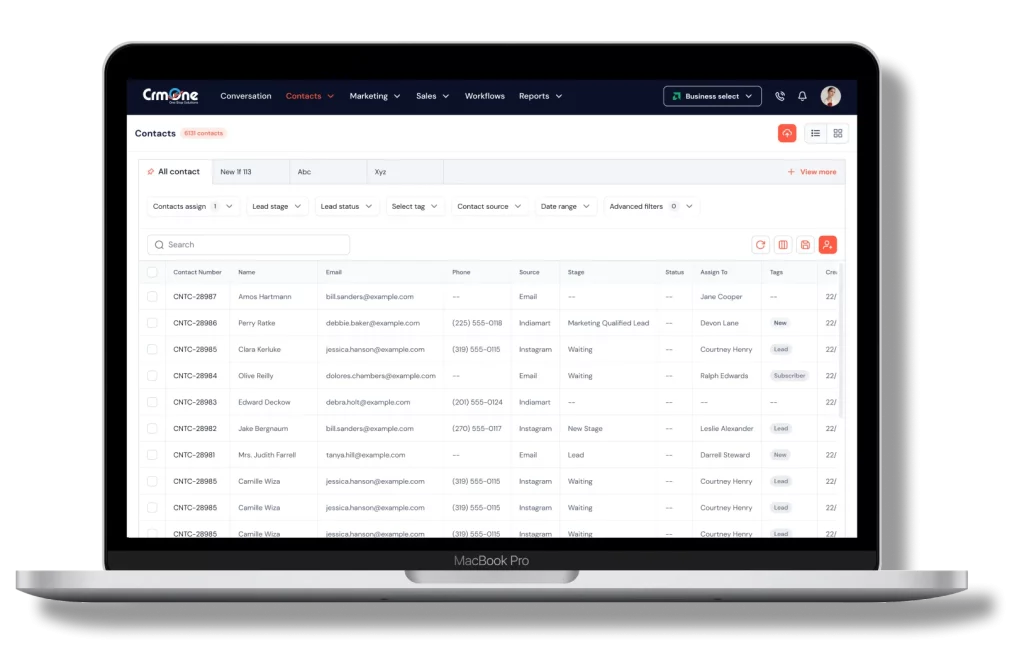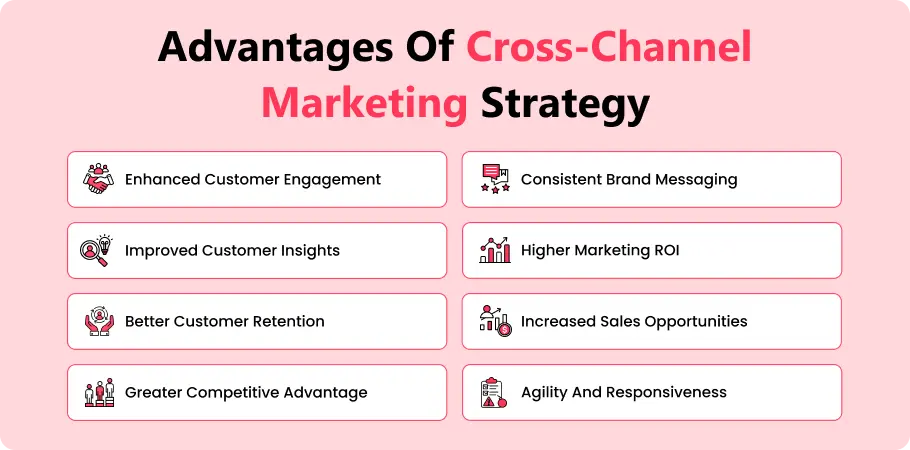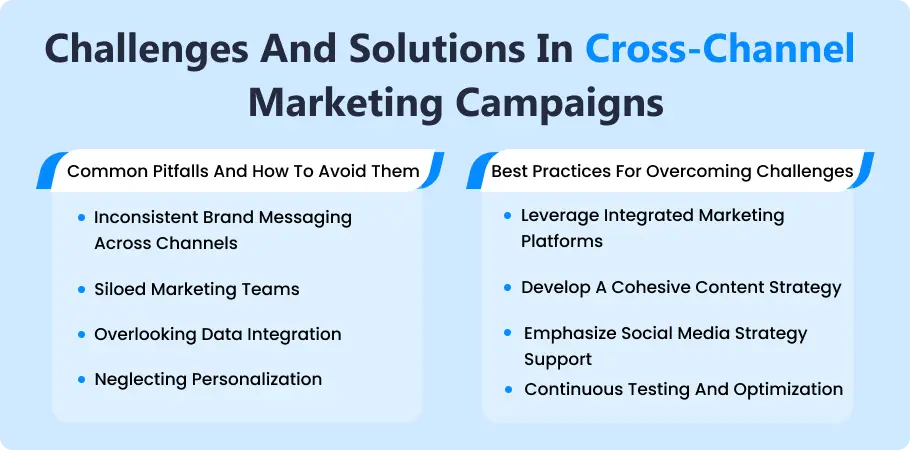In today’s fast-paced digital landscape, businesses continually explore innovative ways to connect with their target audience. A cross-channel marketing strategy emerges as a pivotal approach, allowing companies to seamlessly engage with customers across various marketing channels. This blog delves into the advantages of cross-channel sales strategy, highlighting how it facilitates a cohesive and dynamic interaction between a brand and its target audience.
By integrating multiple marketing channels into a unified marketing strategy, businesses can ensure a consistent and personalized customer experience, regardless of the platform or touchpoint. Join us as we uncover the key benefits of this approach and demonstrate how it can transform how businesses communicate with their audience, enhance customer engagement, and drive marketing success.
What is Cross- Channel Marketing Strategy
Cross-channel marketing, or cross-channel sales strategy, is a sophisticated approach that aligns various marketing efforts across multiple platforms to provide a unified and seamless customer experience. Below, we break down the concept and its evolution for better understanding.
Introduction to Cross-Channel Strategy
Unified Approach
At its essence, cross-channel strategy involves integrating marketing communications across multiple channels to ensure consistency and coherence in the message delivered to the audience.
Customer-Centric
This strategy focuses on creating a seamless customer journey, regardless of the channel or device. This enhances the overall customer experience and fosters loyalty.
The Evolution of Marketing Strategies
From Single to Multiple Channels
Initially, marketing efforts were concentrated on one or two channels, like print and television, with little to no overlap or integration.
Shift in Consumer Behavior
As digital technology evolved, consumers began using multiple devices and platforms, necessitating a more integrated approach from brands.
Agile Marketing Teams
Marketing teams adapted by becoming more interconnected, ensuring all channels worked together cohesively rather than in isolation.
Core Components of Cross-Channel Marketing
Integration Across Platforms
Combining efforts across social media, email, web, and in-person experiences to tell a consistent brand story.
Consistency and Complementarity
Ensuring messages are consistent and complement each other across channels, enhancing the narrative around a brand or product.
Benefits of Adopting a Cross-Channel Approach
Enhanced Customer Experience
By providing a consistent and engaging experience across all touchpoints, brands can significantly improve customer satisfaction and loyalty.
Increased Marketing ROI
Integrated marketing efforts are more effective as they leverage the strengths of each channel, leading to better returns on investment.
The Shift Towards Customer Loyalty
Building Relationships
A cross-channel approach helps build deeper connections with customers. It makes them feel valued and understood across all interactions with a brand.
Repeat Purchases
Satisfied and loyal customers are likelier to make repeat purchases, contributing to the brand’s long-term success.
A cross-channel marketing strategy is essential in today’s fragmented digital landscape. It ensures marketing efforts are more coherent and impactful and is crucial in building and maintaining customer loyalty. By adopting this approach, marketing teams can deliver a more personalized and engaging experience to their target audience, ultimately driving better marketing outcomes and ROI.
Difference Between Cross-Channel and Omnichannel Marketing

Understanding the nuances between cross-channel and omnichannel marketing is crucial for deploying an effective marketing strategy. Though both concepts involve using multiple channels to reach customers, they differ in integration, customer experience focus, and execution strategy.
Definition and Focus
Cross-Channel Marketing
This approach involves using multiple channels to reach and engage customers but ensuring that each channel is optimized for its specific purpose. The channels work together towards a common goal but operate independently.
Omnichannel Marketing
It goes further by using multiple channels and ensuring they are fully integrated, providing a seamless and unified customer experience regardless of the platform or device.
Integration and Customer Experience
Multichannel Marketing
Often considered the precursor to both cross-channel and omnichannel, this strategy uses different channels (e.g., social media platforms, email, physical stores) independently without necessarily integrating the customer experience across these channels.
Cross-Channel Marketing Examples
A company might use social media campaigns to generate interest, send follow-up emails to engage customers, and direct customers to a website to purchase. While these efforts are coordinated, each channel serves a distinct customer journey phase.
Omnichannel Marketing
A retail brand ensures that a loyal customer can start their shopping journey on a mobile app, continue on a website, and complete the purchase in-store without any friction or loss of information. The experience is cohesive, with each channel fully aware and responsive to the interactions on other channels.
Execution Strategy
Single Channel Versus Multiple Channels
While single-channel marketing focuses all efforts on one platform (e.g., only email marketing.), both cross-channel and omnichannel strategies utilize multiple platforms but differ in their integration and consistency across these channels.
Digital Marketing Strategy
In an omnichannel approach, a digital marketing strategy might involve using data from a customer’s online behavior to personalize their in-store experience, such as offering in-store discounts on items they viewed online but didn’t purchase.
Effective Marketing Strategy
An effective strategy, whether cross-channel or omnichannel, depends on the brand’s goals, resources, and customer base. Cross-channel might be preferred for its simplicity and focus, whereas omnichannel offers a comprehensive and integrated experience, often leading to higher customer satisfaction and loyalty.
In summary, while cross-channel and omnichannel marketing strategies involve interacting with customers across multiple platforms, the key difference lies in the degree of integration and the focus on the consistent customer journey experience. Cross-channel emphasizes the efficient use of different channels, often with each serving a specific purpose in the customer journey.
In contrast, omnichannel marketing seeks to blur the lines between channels, creating a unified and seamless experience that enhances customer engagement and loyalty, regardless of how or where the customer chooses to interact with the brand.
Book a CrmOne Demo
Experience the CrmOne simplicity and power. Our experts will show you the best ways to use it and answer your questions in real time. See how CRMOne fits your needs.

Advantages of Cross-Channel Marketing Strategy

Cross-channel marketing and campaign strategy harness the power of multiple channels to communicate with customers, providing a cohesive and integrated experience that aligns with modern consumer behavior. Below are the key advantages of implementing a cross-channel marketing approach:
1. Enhanced Customer Engagement
Personalized Customer Experience
Businesses can tailor customer interactions by leveraging data insights from various channels, leading to more personalized and engaging experiences.
Meaningful Customer Experiences
Cross-channel marketing allows for creating more meaningful and relevant customer experiences by understanding the context and preferences of the audience across different channels.
2. Consistent Brand Messaging
Unified Communication
This strategy ensures that brand messaging is consistent across all platforms, reinforcing the brand’s identity and values, which is crucial for building customer trust and recognition.
3. Improved Customer Insights
Analytics Data
Cross-channel marketing provides a wealth of analytics data from different channels, offering more profound insights into customer behavior, preferences, and trends.
Data Insights for Decision Making
These insights enable businesses to make informed decisions, tailor their marketing strategies, and more accurately predict future consumer behavior.
4. Higher Marketing ROI
Optimized Marketing Efforts
By understanding which channels and messages resonate most with their audience, businesses can optimize their marketing efforts, allocate their budget more effectively, and achieve a higher return on investment.
5. Better Customer Retention
Improve Customer Engagement
Engaging customers across multiple channels and helping consistent, personalized experiences build stronger relationships, improving customer retention rates.
6. Increased Sales Opportunities
Cross-Channel Synergies
By integrating marketing efforts across channels, businesses can create synergies that enhance the customer journey, increasing opportunities for upselling and cross-selling.
7. Greater Competitive Advantage
Differentiation
A well-executed cross-channel marketing strategy can set a brand apart from competitors by offering a seamless and integrated customer experience.
8. Agility and Responsiveness
Quick Adaptation
With insights from various channels, businesses can quickly adapt their strategies to changing customer preferences or market trends, ensuring they remain relevant and competitive.
Cross-Channel Marketing Works
Cross-channel marketing is not just a digital marketing strategy; it’s a comprehensive approach encompassing all digital and physical channels to create a cohesive customer journey. Examples include a retail brand that uses social media ads to drive traffic to a physical store and its website, followed by personalized email campaigns based on the user’s browsing behavior and in-store promotions that reflect online activity.
This integrated approach ensures that no matter how or where a customer interacts with the brand, they receive a consistent message and experience, ultimately leading to improved engagement, loyalty, and sales.
Challenges and Solutions in Cross-Channel Marketing Campaigns

Implementing a cross-channel marketing strategy can significantly enhance customer engagement and brand loyalty. However, it also presents unique challenges that require strategic solutions. Below, we explore common pitfalls in cross-channel marketing and outline best practices for overcoming these obstacles to ensure successful cross-channel campaign management execution.
Common Pitfalls and How to Avoid Them
1. Inconsistent Brand Messaging Across Channels
Challenge
Failing to maintain a consistent brand voice and message across different channels can confuse customers and dilute the brand’s identity.
Solution
Develop a unified brand messaging guide that all marketing teams can follow, ensuring consistency in tone, style, and content across all platforms.
2. Siloed Marketing Teams
Challenge
When marketing teams operate in silos, it leads to disjointed campaigns that lack cohesion across channels.
Solution
Foster cross-departmental collaboration by creating integrated marketing teams to plan and execute campaigns, ensuring channel alignment.
3. Overlooking Data Integration
Challenge
Failing to integrate customer data from various channels can result in a fragmented understanding of customer behavior and preferences.
Solution
Invest in a marketing analytics technology that aggregates and analyzes data across channels, providing a comprehensive view of the customer journey.
4. Neglecting Personalization
Challenge
Treating all customers equally, regardless of their unique preferences and behaviors, can lead to lower engagement and conversion rates.
Solution
Utilize analytics data to create customer segments and tailor marketing messages and offers to meet each segment’s needs and interests.
Best Practices for Overcoming Challenges
1. Leverage Integrated Marketing Platforms
Best Practice
Utilize technology platforms that support integrated marketing efforts, allowing customer data platforms for seamless execution and analysis of campaigns across channels.
Benefit
These platforms enable smarter marketing decisions by giving the marketing team a unified view of campaign performance and customer interactions.
2. Develop a Cohesive Content Strategy
Best Practice
Create a content strategy that aligns with the brand’s objectives and customer expectations, ensuring all content is relevant and consistent across channels.
Benefit
A cohesive content strategy supports a strong brand identity and enhances customer engagement across all touchpoints.
3. Emphasize Social Media Strategy Support
Best Practice
Ensure your social media strategy is integrated with other marketing channels, supporting broader campaign goals and messages.
Benefit
Social media can amplify the reach and impact of your marketing campaigns, driving engagement and conversions.
4. Continuous Testing and Optimization
Best Practice
Regularly test different aspects of your marketing campaigns, from messaging to channel selection, and use the insights gained to optimize future efforts.
Benefit
Testing and optimization ensure that marketing campaigns remain practical and relevant, maximizing ROI and achieving successful cross-channel marketing outcomes. Successful cross-channel marketing requires strategic planning, coordination across teams, and the intelligent use of technology to integrate and analyze data from different channels.
By understanding the common pitfalls and adopting best practices, marketers can create more engaging, personalized, and effective marketing campaigns that resonate with their audience across multiple touchpoints.
Conclusion
Implementing a cross-channel marketing strategy presents a significant opportunity for businesses to enhance customer engagement, streamline their marketing efforts, and, ultimately, drive more substantial ROI. As we’ve explored, the benefits of cross-channel integration are manifold, from creating more personalized customer experiences to making smarter marketing decisions based on comprehensive analytics data.
Embarking on a cross-channel campaign requires careful planning, coordination, and the right technology to integrate and analyze data across channels. However, the effort is well worth it. The benefits of cross-channel over traditional single or multichannel marketing strategies are clear, particularly in how they align with the modern buyer’s journey. Today’s consumers expect seamless interactions with brands, regardless of the channel or device they’re using.
Meeting these expectations can significantly enhance customer loyalty and drive business success. For businesses ready to take their marketing campaign to the next level, adopting a cross-channel marketing strategy is not just beneficial; it’s essential. It offers a holistic view of the customer journey, enabling more meaningful engagements and ultimately fostering a stronger connection between the brand and its audience.
As the digital landscape continues to evolve, the importance of a well-executed cross-channel approach will only grow, making it a crucial component of any successful channel marketing.
Get started for Free
Start for free today. Boost your sales by clicking the Get Started button. With CrmOne, you can manage leads, sales, and customer service all in one place.

